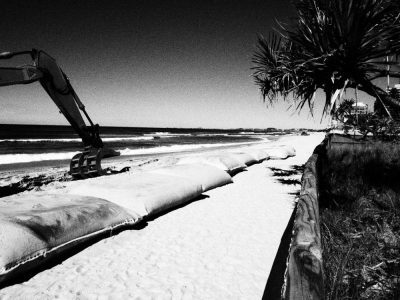Caring for our coasts?

“Shoring up” Gold Coast most iconic beach, Surfers Paradise in 2013 (photo source: Naomi Edwards)
Over the past two weeks I have had the opportunity to lecture to students at two great Australian universities, Sydney and UNSW. The lectures have been in different undergraduate and postgraduate courses. I selected the one topic for these lectures: Caring for our coasts?. This was the same topic that I used for my key note talk at the Sea Change conference in Hobart in 2012, re-cycled and up-dated to the present.
To begin each lecture, I noted that the title has a question mark attached. Why? The coast is contested space. I want to make the point that there are many diverse and often conflicting interests at work in coastal decision-making related to land use planning, management , use, and governance. It is not just a division between private and public land interests; it goes much deeper into ideological divisions about “regulation’’ versus “freedom”, and whether actions taken now should be driven by short-term considerations (short-termism) or whether protecting coastal values in the long term matter. Thus the question mark is placed in the title to offer a focus on issues related to whether we are in a position under current economic and social conditions to really care about what our coastal world will be like in future; put another way, can death by a thousand cuts continue to prevail against an attempt to employ our scientific knowledge of coastal systems that forecasts a damaging legacy for future generations to have to live with.
The Wentworth Group of Concerned Scientists (WG) has been active in the policy debate on the economy versus the environment. Neo-liberal political parties in Australia and elsewhere have long argued the need for policies that place economic growth at the forefront of public discourse. A message frequently heard is that many environmental values must be sacrificed if we are to grow the economy and only by growing the economy through such sacrifices can we then afford to save the environment. The WG in a recent blueprint argued for a Healthy Environment and a Productive Economy, in other words it put forward the case for a longer term vision that shows we can live prosperously in an ever-changing world in ways that do not degrade those natural resources, our natural capital, upon which we and future generations depend for both our livelihoods and lifestyles. Check out our Blueprint on the web site www.wentworthgroup.org.

Longterm shoreline recession on Coochiemudlo Island, Moreton Bay has
inspired the beach’s name to be ‘Graveyard Beach’. (photo source: Naomi Edwards)
From a coastal perspective the lecture looks at what I term the “ Venice Effect’’. I try to show how different places highlighted by experience in Venice, are undergoing increased frequency of high tide inundation. In many estuaries, deltas and low-lying islands, the sea is invading land that rarely was flooded by sea water during non-storm periods. There can be several reasons for this change in frequency and increased areas being affected adversely by salt waters including sea level rise, changes to local tidal planes due to dredging of entrances, and changes in long wave patterns and ocean circulation. Whatever the cause there are pressures on communities and governments to act in ways to protect property, cultural values and threatened ecosystems. Legacy issues such as land titles that have allowed development near foreshores create cries for sea walls and other forms of hard protection as defences against the ravages of the sea. This is occurring on many open coasts exposed to extreme storm events as well as in estuaries. The extent to which sea level rise is contributing to shoreline erosion and recession today is contentious but there can be little doubt that continued rise well into the next century and beyond as confidently projected by ocean scientists will promote changes in shoreline position, over-topping of frontal dunes and damage to public and private property.
So, how can we care for our coast with all this range of pressures as people want to enjoy and benefit from living and playing on our beaches, dunes, rock platforms, waterways and reefs? Here is the foundation for a growing ‘’ saltwater economy’’ from which investors and developers are seeking returns NOW. Local councils seek to benefit and assist those wanting to enjoy coastal amenities, but are they prepared for future shocks including Venice effects? This is where there is an imperative for communities and decision makers to understand the consequences of current actions as they may adversely affect or be adversely affected by extreme storm events, climate change, land clearing in catchments or even social/economic upheavals. Governments over many decades have shown awareness of vulnerabilities and risks facing coastal areas and acted accordingly; the Dutch are a good case as are works to protect London. Sea level projections out to 2300 are cited by the Dutch and German authorities. It is this capacity to think longer term that must be balanced in the minds of decision makers against the demands of present stakeholders. But don’t we all have an interest in future well-being of natural world? This interest should underpin our concerns for urban sprawl, nutrient fluxes into estuaries, building high rise behind beaches, sea wall construction, canal estates, golf course in catchments of ICOLLs, mangrove and salt marsh destruction, and so on. We surely know better and can act with both present and future interests in mind without destroying that which we inherited as beautiful and environmentally sustainable.
– words by Prof Bruce Thom


 MOUTH OF THE RIVER MURRAY
MOUTH OF THE RIVER MURRAY